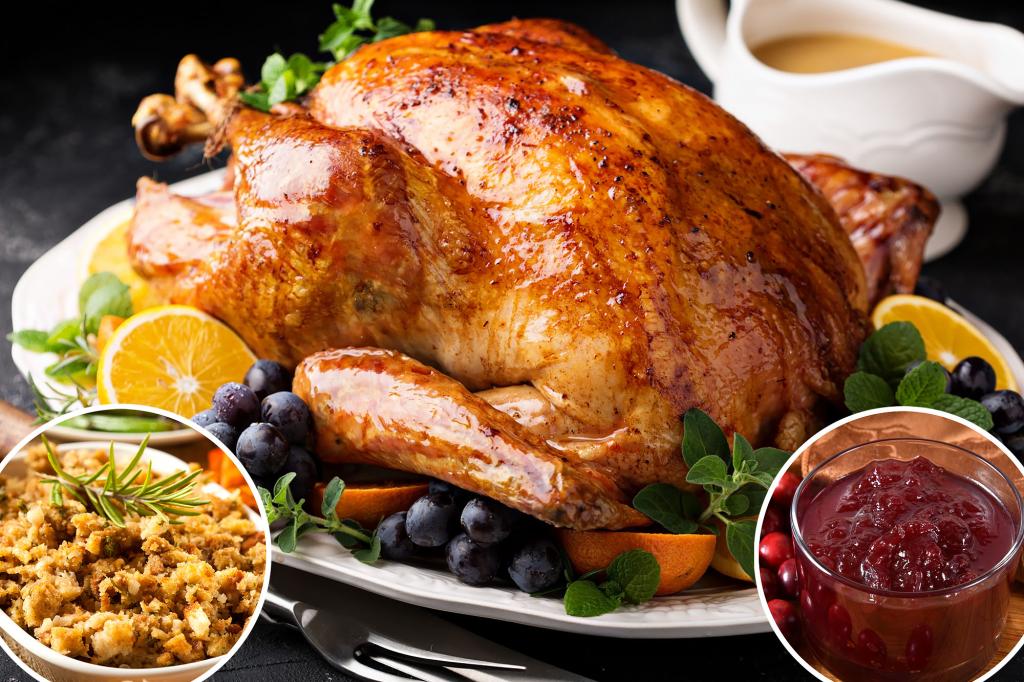Summarize this content to 2000 words in 6 paragraphs
No thanks!
Psst, you don’t have to go into feast mode just because it’s Thanksgiving. It’s possible to enjoy the indulgent holiday without feeling overstuffed.
Stephanie Schiff, a registered dietitian nutritionist at Northwell Huntington Hospital, said that what and when you eat makes all the difference on Thanksgiving.
For example, you’ll want to start the day with breakfast. Skipping meals in the hours and days before Thanksgiving can easily lead to overeating, Schiff warned.
She recommended having your big meal at lunchtime or in the early evening to allow more time for digestion and to improve blood sugar levels, making it easier to get a good night’s sleep.
Schiff also suggested moving your body after every meal or snack.
“Instead of immediately sitting down in front of the TV to watch the game, go outside and throw a football around,” she told The Post. “If you have prediabetes or diabetes, post-meal activity can reduce post-meal blood sugar spikes.”
You should eat until you’re 80% full and thoughtfully consider your menu — don’t just wing it.
Schiff shared nine of the best and worst foods for your Thanksgiving plate — and how to make them healthier.
Turkey
Let’s talk turkey. Schiff considered the traditional Thanksgiving bird — especially the breast — a quality lean protein but warned against consuming too much of the caloric, fatty skin. She said the skin can add 40 calories and a gram of fat to a 4-ounce serving of roast turkey.
She also noted that brined turkey, which has been soaked in a very salty solution, may not be suitable for people with high blood pressure because of the extra sodium.
Vegetables
Veggies are good for you by design, but how you cook them matters. Schiff recommended sauteing them in olive oil, which has heart-healthy monounsaturated fats, instead of butter.
She said serving a salad or soup as the first course will fill you up.
“Veggies first can help reduce your blood sugar spike after a meal,” Schiff explained. “Use nuts for crunch in your salad — they add heart-healthy fats, protein, fiber, vitamins, minerals and taste!”
Cranberry sauce
Cranberries can be a sweet — or, even better, a not-so-sweet — addition to your Thanksgiving meal.
Schiff eschewed ribbed cranberry in a can in favor of whole cranberry sauce, which boasts fiber and antioxidants, or homemade sauce.
“Follow the recipe on the back of a package of frozen cranberries,” she directed. “You can cut sugar amounts by one-third or more, or use a natural, non-caloric sweetener like Stevia. I love adding toasted walnuts to my cranberry sauce for crunch and a little healthy fat.”
Stuffing
Stuffing can be more nutritious, Schiff said, when you substitute chicken broth for butter or cut butter from the recipe by two-thirds.
Adding sauteed vegetables, like celery and onions, and roasted chestnuts ups the nutrient and fiber content.
Potatoes
Schiff shaded white potatoes as a starchy side that can quickly raise blood sugar. She preferred sweet potatoes, which are rich in fiber, antioxidants, and vitamins A and C.
“Serve them mashed or baked instead of white potatoes,” she advised.
Even better, shred the sweet potatoes, add shredded zucchini and form the mixture into potato pancakes. “They will be higher in fiber and nutrients and taste delicious!” she said.
Gravy
Gravy is not known for being healthy — it’s often laden with saturated fat, salt, flour and butter.
Schiff suggested pouring the turkey drippings into a clear container, like a measuring cup, and waiting a few minutes for the fat to rise to the top. “You can skim a lot of it off,” she said.
Pie
Often the cherry on top of a hearty Thanksgiving meal, pie can be made healthier.
“Go for single-crusted or even crustless pies — you’ll avoid some of the heart-clogging saturated fat,” Schiff said. “Pumpkin pie without a crust is still creamy and delicious.”
Hot chocolate
A recent study found that flavanol-rich hot cocoa can help counteract the negative effects of a fatty meal on blood vessel function.
Schiff cautioned against drinking instant hot chocolate, which typically has too much sugar.
“Use 100% cacao (or cocoa). It has no fat, no sugar and is high in antioxidants,” she said. “Add your own low-fat milk, a little sugar or non-caloric sweetener and a dash of vanilla extract. Heat and drink.”
Eggnog
Eggnog has become a popular holiday tradition that has some health benefits.
The cream and egg provide protein, and the added spices offer antioxidants. But these pros are often canceled out by the fat, sugar, carbs and alcohol.
Schiff proposed having just a taste or putting your eggnog in a shot glass.
“It will look elegant and you’ll still be satisfied,” she promised. “You can also find low-fat/low-sugar versions in the supermarket.”


